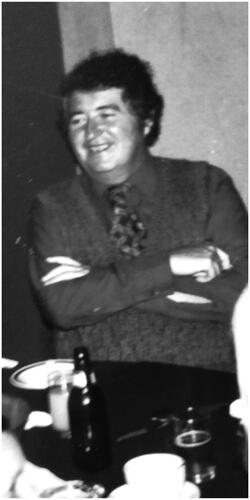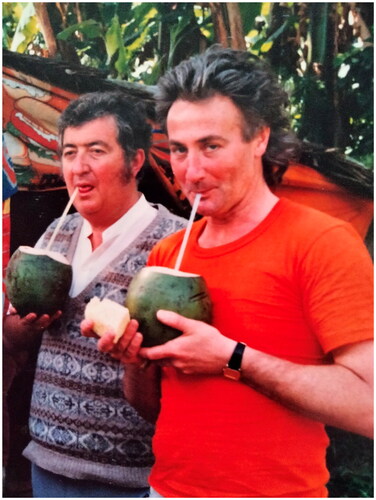On December 11, 2022 former Journal of Contemporary Asia co-editor Bruce McFarlane passed away.
Bruce was with the journal from the beginning. For much of the period he was on the journal’s editorial board, he collaborated closely with Peter Limqueco. Peter also passed in 2022 (Hewison Citation2022). Bruce had been in poor health for some time, but remained a diligent correspondent, writing several letters in 2022 to comment on the journal, lamenting Peter’s passing, while continuing his academic thinking and writing.
Bruce’s first article for the journal appeared in its fourth issue (McFarlane Citation1971). He was first listed as a member of the Editorial Board in in 1972 and he became co-editor in 1980, a position he held until he retired in 2005.
Peter and Bruce guided the journal through decades of both socialist and capitalist crises, technological innovation, and generational change (Limqueco and Hewison Citation2010). For more than a decade, when Peter and Bruce managed the journal from Manila, Bruce spent considerable time in the Philippines. In those days, the journal owed its existence to the long hours put in by Peter and Bruce.
In 2021, the journal published a tribute to Bruce, authored by his friend and comrade Humphrey McQueen. That article provides a colourful description of Bruce’s socialism and activism as well as an account of his academic writing. It is a companion to Humphrey’s comprehensive webpage on Bruce and his work, political and academic, where the introduction, written in 2016, states that it “celebrates the achievements of Bruce McFarlane … both as a tribute a friend and comrade for fifty-six years, and to enrich collective awareness of how much cutting-edge Marxism has been produced here [in Australia]…” (https://www.surplusvalue.org.au/Bruce%20McFarlane.html).
Bruce’s Australian connections were obvious in early issues of the journal, but so too were his extensive international contacts. Bruce graduated from University of Sydney, and between 1957 and 1960, he was working on planning in Yugoslavia and then moved on to the Indian Planning Commission where Michal Kalecki also worked. His interest in India and planning produced two articles for the journal (Limqueco and McFarlane Citation1979; McFarlane Citation1982). He then moved on to Cambridge University where Joan Robinson and Maurice Dobb were influential. In Australia, Bruce taught economics at the University of Queensland, Political Science at the Australian National University and the University of Adelaide, where he was Professor, before becoming Professor of Economics at the University of Newcastle.
A prolific author, Bruce published more than a dozen books from Economic Policy in Australia: The Case for Reform (McFarlane Citation1968) and The Chinese Road to Socialism: Economics of the Cultural Revolution with Ted Wheelwright (Wheelwright and McFarlane Citation1970) to A Manual of Political Economy with Melanie Beresford (McFarlane and Beresford Citation1985). There were scores of journal articles and book chapters.
More than his capacity for theoretically-informed academic writing, Bruce had a marvellous capacity for enthusing others, and especially young scholars. In a wonderful tribute, Berenice and Chris Nyland (2022) explain that Bruce was a “brilliant lecturer,” and a popular and admired teacher. Even though I had never met him, it was Bruce who, in his almost indecipherable scrawl, invited me to present my very first conference paper, to a Journal of Contemporary Asia conference in Adelaide in 1981. That Adelaide conference brought together academics, unionists, and activists who grappled with questions of imperialism, dependency, and Australia’s position in the region, all arenas where Bruce published important work (Catley and McFarlane Citation1974; McFarlane Citation1977; Catley and McFarlane Citation1980).
One of Bruce’s abiding academic concerns was economic theory, resulting policy, and the impacts of policy implementation. For the Journal of Contemporary Asia, he returned to these questions several times, from his first article in 1971 to his discussion, with Melanie Beresford, of comparative regional development, looking at China and Vietnam (Beresford and McFarlane Citation1995). Bruce’s familiarity with a broad range of economic and political theory was evident in all of his articles for the journal, and especially in his last articles for the journal, the encyclopaedic discussion of the Asiatic mode of production. Fittingly, this account was completed with Steve Cooper who had a career in Australian unions and Miomir Jaksic from the Economics Department at the University of Belgrade (McFarlane, Cooper, and Jaksic Citation2005a, Citation2005b).
Bruce’s theoretical mastery also marked his writing on Southeast Asia’s development boom and in his perspective on the Asian Economic Crisis of the late 1990s. In “Growth and Cycles in Southeast Asian Development,” he detailed various Marxist and orthodox approaches to short and long cycles of growth and crisis. He rejected dependency and Maoist arguments that viewed the region’s industrialisation as warped or insubstantial. Rather, he considered:
the Southeast Asian countries have done very well in terms of growth of output, increased and better structured capital accumulation, and exports…. [T]here is less emphasis these days on export of food (unprocessed), staples, tin and rubber as a result of policies which have increased the share of manufactures, especially the capital-goods sector in both total output and exports (McFarlane Citation1988, 132).
In fact, that restructuring resulted in an economic boom in regional economies that led inexorably to a deeper crisis that began in mid-1997. Bruce declaried this crisis “a failure of market forces as propelled through profit-hungry private sector economic agents” (McFarlane Citation1999, 72). The bail outs by international financial institutions (IFIs) meant that the “power of entrenched elites” was not about to be shaken for “getting the [economic] fundamentals right” would “not mean better regulation, restored national sovereignty, high living standard and more equitable distribution of wealth and income (which are the ‘fundamentals’ of the masses) but things like conservative monetary policy, low budget deficits, small balance of payment deficits – the fundamentals of the bankers and money market speculators” (McFarlane Citation1999, 74).
He followed this with a theoretically-engaged discussion of oligopolistic capitalism and imperialism, emphasising the enhanced position of finance capital and the IFIs. Interestingly, he also made an all too neglected point about the class nature of “civil society” and its ideological use by Western financial interests as international finance capital has sunk deep roots in the region (McFarlane Citation2001, 221–222, 238). Domestically, he pointed to the Crisis as bringing some change for local capitalist classes while observing that “there would be a concentration of new ownership in the hands of a few families and individuals…” (McFarlane Citation2001, 234). He was right and huge wealth were amassed among a few families in each of the countries of the region.
In concluding his tribute to Bruce, McQueen (Citation2021, 202) wrote:
He has done the things about which he has written. His critiques of political economy are practical and conceptual, as courageous as they are penetrating. He has put his body on the line and his brains on the line in the service of working people, standing forever with the weakest and the poorest across the globe.
References
- Beresford, M. and B. McFarlane. 1995. “Regional Inequality and Regionalism in Vietnam and China.” Journal of Contemporary Asia 25 (1): 50–72.
- Catley, B. and B. McFarlane. 1974. “Prospects for Revolution in South-East Asia in the Next Decade: The Role of Australia.” Journal of Contemporary Asia 4 (3): 308–323.
- Catley, B. and B. McFarlane. 1980. “An Australian Perspective on the ‘New International Economic Order’.” Journal of Contemporary Asia 10 (1/2): 166–180.
- Hewison, K. 2022. “Peter Limqueco (1939–2022).” Journal of Contemporary Asia 52 (5): 691–695.
- Limqueco, P. and K. Hewison. 2010. “Editorial: Forty Years of the Journal of Contemporary Asia.” Journal of Contemporary Asia 40 (4): 537–538.
- Limqueco, P. and B. McFarlane. 1979. “Problems of Economic Planning for Underdeveloped Socialist Countries.” Journal of Contemporary Asia 9 (1): 5–26.
- McFarlane, B. 1968. Economic Policy in Australia: The Case for Reform. Melbourne: Cheshire.
- McFarlane, B. 1971. “Economic Policy and Economic Growth in China.” Journal of Contemporary Asia 1 (4): 19–32.
- McFarlane, B. 1977. “Imperialism into the 1980’s.” Journal of Contemporary Asia 7 (4): 453–461.
- McFarlane, B. 1982. “A Note on Mahalanobis' Neo-Marxian Development Model.” Journal of Contemporary Asia 12 (3): 340–343.
- McFarlane, B. 1988. “Growth and Cycles in Southeast Asian Development.” Journal of Contemporary Asia 18 (2): 119–138.
- McFarlane, B. 1999. “The Unfolding of the ASEAN Economic Crisis.” Journal of Contemporary Asia 29 (1): 56–75.
- McFarlane, B. 2001. “Politics of the World Bank-International Monetary Fund Nexus in Asia.” Journal of Contemporary Asia 31 (2): 214–240.
- McFarlane, B., and M. Beresford. 1985. A Manual of Political Economy. Manila: Journal of Contemporary Asia Publishers.
- McFarlane, B., S. Cooper, and M. Jaksic. 2005a. “The Asiatic Mode of Production – A New Phoenix (Part 1).” Journal of Contemporary Asia 35 (3): 283–318.
- McFarlane, B., S. Cooper, and M. Jaksic. 2005b. “The Asiatic Mode of Production – A New Phoenix (Part 2).” Journal of Contemporary Asia 35 (4): 499–536.
- McQueen, H. 2021. “A Noble Protagonist of the Proletariat and the Peasantry: A Tribute to Bruce McFarlane.” Journal of Contemporary Asia 51 (2): 190–206.
- Nyland, B. and C. Nyland. 2022. “Celebrating the Life of Bruce McFarlane.” Pearls and Irritations, December 23. Accessed December 25, 2022. https://johnmenadue.com/celebrating-the-life-of-bruce-mcfarlane/.
- Wheelwright, T., and B. McFarlane. 1970. The Chinese Road to Socialism: Economics of the Cultural Revolution. New York: Monthly Review Press.


